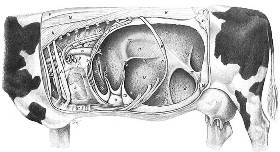The benefits of yeast in ruminant nutrition

Some 300 delegates went to Lille in France to attend the first world symposium “Yeast solutions – the benefit of using live yeasts in ruminant nutrition” organised by LeSaffre Feed Additives. Five renowned speakers talked about the latest developments in this field.
A number of strategies have been used to enhance ruminal fermentation. Antibiotics and ionophores have been effective but were banned in the EU at the beginning of 2006 for safety reasons.
Direct fed microbials
To substitute these questionable ingredients biological additives have been introduced, including microorganisms, enzymes and plant products. “None of these manipulating additives has been introduced in a rational way until now”, said John Wallace, group leader of the Microbial Metabolism group at the Rowett Institute in Scotland. “Their effects were discovered only after overall benefit had been observed.”
To substitute these questionable ingredients biological additives have been introduced, including microorganisms, enzymes and plant products. “None of these manipulating additives has been introduced in a rational way until now”, said John Wallace, group leader of the Microbial Metabolism group at the Rowett Institute in Scotland. “Their effects were discovered only after overall benefit had been observed.”
Wallace believes direct fed microbials arguably offer the greatest potential for manipulation of ruminal fermentation. “They offer a huge spectrum of metabolic activities and enzymes as well as metabolites. They also enable selection of strains or mutants best suited for particular applications,” Wallace said.
Saccharomyces cerevisiae
Wallace thinks the yeast species of Saccharomyces serevisiae is an especially attractive organism in ruminants. “It is metabolically active in the rumen but does not grow, which means that its construction and activity can be readily controlled by its dietary inclusion level, ensuring maximum efficacy.”
Wallace thinks the yeast species of Saccharomyces serevisiae is an especially attractive organism in ruminants. “It is metabolically active in the rumen but does not grow, which means that its construction and activity can be readily controlled by its dietary inclusion level, ensuring maximum efficacy.”
The yeast does not grow in the rumen due to the high concentration of volatile fatty acids, but remains biochemically active. Its suggested mode of action is, amongst others, scavenging oxygen, which needs to be absent in the anaerobic environment of the rumen. “As a result we see increased bacterial viability,” Wallace said.
Redox potential
Reduction potential (also known as redox potential, oxidation / reduction potential or ORP) according to Wikipedia is a measure of the tendency of a chemical species to acquire electrons and thereby be reduced.
Reduction potential (also known as redox potential, oxidation / reduction potential or ORP) according to Wikipedia is a measure of the tendency of a chemical species to acquire electrons and thereby be reduced.
Reduction potential is measured in volts (V), millivolts (mV), or Eh (1 Eh = 1 mV). Each species has its own intrinsic reduction potential; the more positive the potential, the greater the species’ affinity for electrons and tendency to be reduced.
Emilio Ungerfeld of Lethbridge Research Centre (Agriculture and Agri-Food Canada) elaborated on the biological significance of the measurement of redox potential.
In the rumen, the main electron donors are carbohydrates and some important electron acceptors are CO2, formate, oxaloacetate, fumerate, pyruvate, and others.
The main electron sinks (uptakes) are |NH3, propionate and microbial mass, and the carbon sinks are acetate, propionate, butyrate, CO2, NH3 and microbial biomass.
Ruminal competition
“Ruminal fermentation pathways compete for electrons and carbon,” Ungerfeld said. “It is of interest to understand how that competition is controlled.”
“Ruminal fermentation pathways compete for electrons and carbon,” Ungerfeld said. “It is of interest to understand how that competition is controlled.”
After the theoretical discussion of Ungerfeld, Corine Bayourthe from the National School of Agronomy in Toulouse, France shared more practical experiences with redox status as a promising new way to explore live yeast metabolism in the rumen.
According to Bayourthe, “the redox reductions that prevail in the gut can have a major impact on the digestion, metabolism and assimilation of ingested nutrients. The oxygen status determines whether anaerobic fermentation or aerobic oxidation of nutrients prevail.”
Earlier research had shown that the rumen contents of dry and lactating cows had a markedly negative Eh varying from -220 to -115 mV. “If the level of dry matter intake could partly explain the variation between these values, then the type of diet fed could also influence Eh,” Bayourthe said.
Research by Julien and co-workers in 2010 focused on Eh in the rumen. It was found that a fibre-rich diet is characterised by low Eh values of the ruminal content, while a high Eh is observed with a ready fermentable carbohydrates0rich diet. According to Julien the Eh directly originated from microbial activity. It reflects an environment with strong reducing potential due to the quasi-absence of oxygen, favourable to strictly anaerobic bacteria.
Role of yeast in reducing Eh
Live yeast used as a dietary feed additive for dairy cows present an intrinsic capacity to reduce the Eh level studies revealed. “Live yeast supplementation via the modulation of ruminal Eh can be a good means to stimulate adequate microflora for better digestive efficiency of the diet,” Bayourthe said.
Live yeast used as a dietary feed additive for dairy cows present an intrinsic capacity to reduce the Eh level studies revealed. “Live yeast supplementation via the modulation of ruminal Eh can be a good means to stimulate adequate microflora for better digestive efficiency of the diet,” Bayourthe said.
Furthermore live yeast influences the bacterial populations in the rumen, a subject Jamie Newbold of the Aberystwyth University in Wales in the UK presented in more detail. He is intrigued by the fact that feeding live yeast at non-nutritional levels (0.5-20g/d) effects the bacterial population in the rumen. “Doing so we see an increase in microbial protein and more fibre degradation, and above all in increase in bacterial numbers, even op to 130%,” Newbold said.
Oxygen scavenging capability
Newbold suggests that yeast stimulates oxygen removal in the rumen, because oxygen slows down bacterial activity. However, not all yeasts have the same scavenging capabilities. Also different levels of yeast give different levels of bacteria.
Newbold suggests that yeast stimulates oxygen removal in the rumen, because oxygen slows down bacterial activity. However, not all yeasts have the same scavenging capabilities. Also different levels of yeast give different levels of bacteria.
“We have noted that not all strains of yeast are capable of stimulating digestion in the rumen. Certain strains of Saccharomyces cerevisiae can help prevent the decrease in rumen pH associated with feeding a cereal based diet and this appears to be associated with a decrease in rumen lactate concentrations,” Newbold said. “However, it is not clear yet how yeast prevents the post feeding decline in rumen pH.”
Newbold concluded that S. Cerevisiae can help prevent a post feeding drop in rumen pH in animals fed concentrate diets and thus reducing the likelihood of both clinical and subclinical acidosis. “This appears to be due to the ability of the yeast to selectively stimulate the growth of lactate utilising bacteria in the rumen,” Newbold said.
Field application
As Newbold already suggested, can yeast help in prevention of acidosis. Scientists around the world give their own description and definition of acidosis, which basically originates from an accumulation of strong acids in the rumen due to the consumption of a large proportion of readily fermentable carbohydrates by the cow.
As Newbold already suggested, can yeast help in prevention of acidosis. Scientists around the world give their own description and definition of acidosis, which basically originates from an accumulation of strong acids in the rumen due to the consumption of a large proportion of readily fermentable carbohydrates by the cow.
Newbold also noted that both bicarbonate and yeast simulate bacterial growth, probably due to the rise of pH. But only yeast stimulates lactic acid consuming bacteria.
Research at LFA
Jean-Philippe Marden of LeSaffre Feed Additives (LFA) considers redox potential a valuable tool in reducing acidosis incidences. “For seven years now, LFA Ruminant research team devoted much interest in the proper measurement and interpretation of such parameters that can be applied in the rumen environment,” he said.
Jean-Philippe Marden of LeSaffre Feed Additives (LFA) considers redox potential a valuable tool in reducing acidosis incidences. “For seven years now, LFA Ruminant research team devoted much interest in the proper measurement and interpretation of such parameters that can be applied in the rumen environment,” he said.
After the setting up of a redox measurement methodology, the gathered Eh data proved to be complementary to pH in order to better approach rumen bioenergetics and the involved mechanisms.
“The redox and bioenergetic concept coupled with evolving bio-molecular techniques allowed a better understanding in the mode of action of live yeast in ruminants,” Marden said. As an example he said that in a comparison between two different buffering agents – live yeast and bicarbonate – showed different actions on rumen physio-chemical, fermentation and fibre degradation parameters.
Further research in developments is carried out at LFA. Marden said the objectives were to find new measuring redox probes for non-cannulated and pasture-fed animals along with modelling of Eh regarding diet composition and feed additives.











